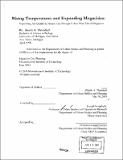Rising temperatures and expanding megacities : improving air quality in Mexico City through Urban Heat Island mitigation
Author(s)
Thundiyil, Karen A., 1976-
DownloadFull printable version (8.072Mb)
Alternative title
Improving air quality in Mexico City through UHI mitigation
Other Contributors
Massachusetts Institute of Technology. Dept. of Urban Studies and Planning.
Advisor
Joseph Ferreira, Jr.
Terms of use
Metadata
Show full item recordAbstract
Mexico City exists as a city space pushed and pulled in multiple directions. Different scales and levels of spatial reference and planning have come together to produce a dynamic and contradictory place united by the identity of Mexico City. Unfortunately, the city faces a regional environmental dilemma stemming from its chronic air pollution problem. Many steps have been taken to reduce air pollution in the city and this study examines an additional air quality improvement strategy that has been implemented in other megacities. Singapore and Tokyo have supplemented their air pollution reduction programs with Urban Heat Island (UHI) mitigation plans. Across the globe, cities experience a phenomenon called the UHI effect where urban areas are several degrees warmer than neighboring suburban or rural areas. A cycle of consuming more energy for cooling purposes adds to greenhouse gas production from the additional power generation and then feeds back to the system with yet higher temperatures in the city. In addition, higher ambient temperatures help speed the formation of smog. This study examines what Tokyo and Singapore have done in terms of an UHI mitigation plan, analyzes what can be done to reduce the UHI effects in Mexico City to improve air quality and quantifies the effects of potential physical changes. Modest surface changes are modeled and predicted to reduce average temperature by more than a full Fahrenheit degree. A decrease in surface temperature can slow the formation of smog and can help mitigate the impacts of the Urban Heat Island effect.
Description
Thesis (M.C.P.)--Massachusetts Institute of Technology, Dept. of Urban Studies and Planning, 2003. Includes bibliographical references (leaves 57-60).
Date issued
2003Department
Massachusetts Institute of Technology. Department of Urban Studies and PlanningPublisher
Massachusetts Institute of Technology
Keywords
Urban Studies and Planning.